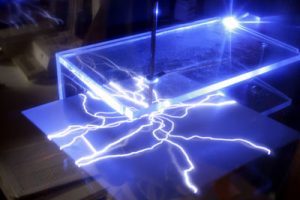Best Coating for Dielectric Strength
Posted by Sean Horn
Friday, December 22, 2017 8:00
@ 8:00 AM
Dielectric strength is a measurement of a conformal coating’s insulation effectiveness. The higher the numerical designation of strength, the more likely a coating is to resist dielectric breakdown — a level of 7,000 is dielectrically stronger than 2,200. Conformal coatings with higher hydrophobic properties and lower extractible ionic impurities are less likely to attract water, rendering them less mobile, while enhancing existing dielectric strength
Conformal coating protects and prolongs the usage of printed circuit boards (PCBs). Although ostensibly designed with sufficient protection during normal operation, PCB performance/service life responds well to conformal coating application. Coating increases dielectric strength between conductors enabling smaller, more compact PCB design. It also protects circuitry and components from abrasion and solvents. It is imperative, however, that the applied coating has no adverse impact on the dielectric strength in air (approximately 3 kV/mm.), which can be altered by such factors as
- the shape and size of the assembly’s electrodes, and
- increases in air-pressure.
The objective is to avoid reaching the coating’s breakdown voltage, the minimum difference in charge between two points in an electrical field, causing the insulating conformal film to become electrically conductive. A primary function of all conformal coatings is maintaining sufficient insulation and avoid dielectric breakdown.
In this context, the dielectric constant measures the coating’s response to electric field. A dielectric constant measuring more than 3.0 indicates molecular response to the alternating field and current might be sufficient to vary circuit speed, an undesirable outcome for higher frequency assemblies. A coating’s internal molecular friction is designated as dielectric loss; numerical values greater than 0.1 indicate excess heat is being generated within the molecule, an undesirable property for any conformal coating.

Conformal Coating Dielectricity
Conformal coating provides a protective, nonconductive dielectric covering for PCBs, adding security from the incursion of external elements that cause corrosion and contamination. The four liquid types of conformal coating — acrylic, epoxy, silicone and urethane – are joined by a fifth, non-liquid parylene, derived through vapor-phase polymerization.
Liquid coatings are applied to PCBs by wet techniques, incorporating saturated-brush, immersion (dipping the component in a tank of liquid film material) or spray methods, to transfer the coating onto substrates. Generally inexpensive and simple to enact, surfaces are coated reliably.
Parylene’s chemical vapor deposition (CVD) method converts powdered parylene dimer into a gas, which permeates deep within the surface of electronic assemblies when heated in a vacuum, providing a more comprehensive coating than the surface treatment offered by liquid coatings. More reliable, CVD is considerably slower and more expensive to implement than wet application methods.
Dielectric mediums can store energy because they support electrostatic fields that diffuse thermal energy at a minimal rate. Lower dielectric constant represents lower concentrations of electric flux; these levels vary according to conformal coating material and even within material type.
For instance, as Table 1 shows, dielectric properties differ according to parylene type — the dielectric constant for parylene N is 2.65, while parylene C is 2.95; other parylene types range between 2.25 – 3.15. These levels also change as the Hertz (Hz) value changes; a unit of change-frequency for alternating current (AC), the common Hz-level in the U.S. is 60 Hz – wherein current changes direction/polarity 120 times (60 cycles)/second. Parylene C’s dielectric constant declines as Hz levels increase, from 3.15 at 60 Hz to 2.95 at 1 MHz; Parylene N’s levels remain constant, at 2.65. Parylene C’s dissipation factor (dielectric loss) diminishes from 0.020 to 0.013, from 60 Hz – 1 MHz; N’s value increases from 0.0002 to 0.0006. In both cases, figures indicate manageable levels of internal heat (0.1) within substrates coated by parylene. See Table 1 for further data.
TABLE 1: Dielectrical Properties of Conformal Coatings
PROPERTIES Dielectrical strength, V/ml Dielectric constant
COATING TYPE
Parylene N 7,000 2.65
Parylene C 5,000 2.95 – 3.15
Acrylic 1,500 3.25 – 4.35
Epoxy 2,200 3.30 – 4.60
Silicone 2,000 3.10 – 4.20
Urethane 3,500 3.80 – 4.40
Compared to liquid coatings, parylene’s lower dielectric constants show its facility resisting powerful electrical fields. Its higher dielectrical strength indicates superior capacity for providing substrates dielectric protection. A distinct benefit of parylene is a greatly diminished tendency to degenerate when subjected to substantial electrical activity.
Compared to parylene, all liquid coatings register a dielectric constant greater than 3.0, suggesting potential variance in circuit speed, which can disrupt the performance of higher frequency assemblies. In contrast, lower dielectric-constant materials like parylene consist of weakly-bonded molecules, stimulating production of dependable buffers between a PCB and its operating environment. Polarized by electrical charges, parylene resists electrical conduction, enhancing its value as a coating for high-speed electrical components, in a manner superior to liquid coatings.
Wet coatings exhibiting higher dielectric constants have lower dielectric strength; they are more likely to break down during prolonged contact with intense electrical activity. In contrast, parylene conformal films seldom conduct current or are exposed to dielectric breakdown; in rare occasions they are, the condition is temporary, abating with elimination of the excessive electric field. At that point, parylene reverts to its normal, non-conductive dielectric state, relieving the coating from permanent damage. Parylene coatings sustain an electric field without conducting electricity, facilitating safe transmission of electrostatic lines of force through protected components.
If you’re looking for conformal coating services for circuits, contact Diamond-MT today. We provide high-quality parylene and conformal coating services. Contact us today to discuss your project needs with our team of experts. Get started by calling us at 814-535-3505 or completing a quote request.
Comments
Homepage 4/17/2020. 10:17:10 AM
... [Trackback] [...] Informations on that Topic: blog.paryleneconformalcoating.com/whats-the-difference-between-potting-and-conformal-coating/ [...]

londondrugscanada.bigcartel.comlondon-drugs 4/17/2020. 10:17:10 AM
cialis uk https://londondrugscanada.bigcartel.com/london-drugs This is nicely expressed. !